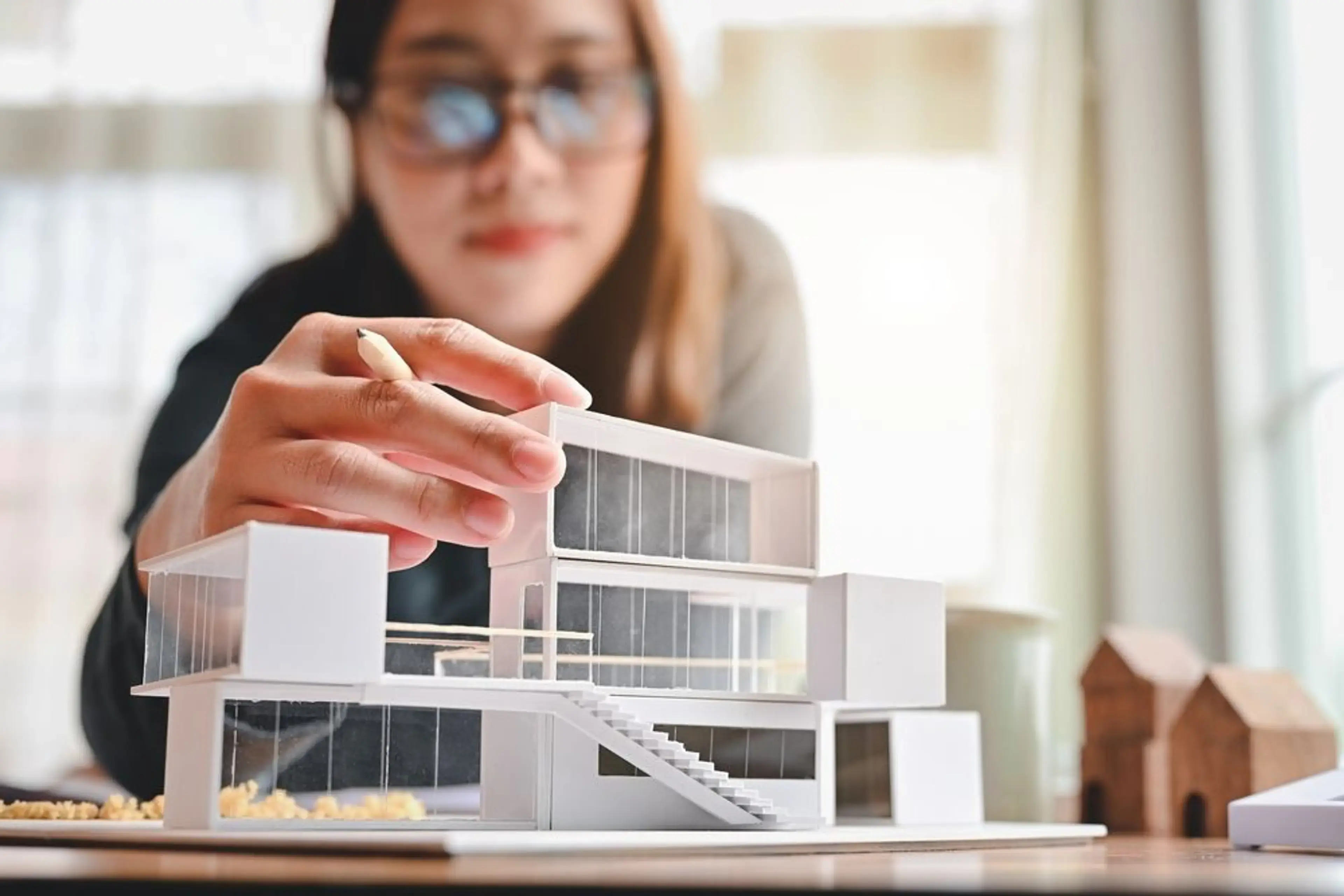Architect Salary Overview by City and Level
Architect Salary Overview by City and Level
Blog Article
Recognizing the Diverse Career Paths Available for Aspiring Architect
As a hopeful Architect, you have a globe of occupation courses waiting on you. Each path uses one-of-a-kind challenges and chances to use your creativity and technical know-how. Whether you're attracted to traditional style or the nuances of lasting layout, there's a niche that lines up with your passions. Understanding these varied alternatives can shape your specialist journey, yet which direction will you pick to explore first?
Conventional Design: Creating Structures and buildings
Typical architecture concentrates on developing structures and frameworks that blend capability with visual appeal. Your designs can show cultural heritage, showcasing regional traditions while meeting modern-day needs.
You'll establish skills in preparing, model-making, and website analysis, allowing you to visualize and communicate your ideas effectively. Involving with customers, you'll need to comprehend their vision and translate it into possible layouts.
Moreover, developing codes and sustainability methods are necessary in your job, guaranteeing your frameworks are environmentally friendly and risk-free. As you grow in your profession, you'll find chances in domestic, business, or also restoration jobs, each offering special challenges. Embracing typical design paves the way for a satisfying profession that pays homage to the past while forming the future.
Urban Preparation: Forming Areas and Public Spaces
As an ambitious Architect, you can play a necessary function as a city coordinator, transforming just how communities interact and work. By utilizing area engagement strategies, you'll assure that locals have a voice fit their setting. And also, incorporating sustainable style concepts will certainly aid produce areas that not just fulfill today's demands yet additionally secure the future.
Function of Urban Planners
While several might assume of architects as the single dreamers behind structures, urban organizers play a necessary role in shaping the wider landscape of areas and public rooms. By collaborating with various stakeholders, you'll help develop parks, transportation systems, and domestic areas that advertise social communication and accessibility. Your knowledge in spatial style and neighborhood dynamics permits you to picture future development while maintaining cultural heritage.
Area Engagement Methods
Efficient community interaction techniques are vital for metropolitan planners to assure that the voices of citizens are listened to and valued in the preparation process. To foster meaningful discussion, you ought to prioritize open forums and workshops where community members can reveal their concepts and issues. By actively listening and integrating responses, you'll create spaces that reflect the community's needs, inevitably leading to more successful and lasting urban environments.
Sustainable Design Principles
When developing metropolitan areas, incorporating sustainable style concepts is crucial for producing settings that thrive both ecologically and socially. You must start by concentrating on energy efficiency, making use of products that lower waste and advertise recycling. Think about incorporating green areas, like yards and parks, to enhance biodiversity and boost air high quality. Advertising walkability and public transportation can minimize reliance on vehicles, promoting a much healthier community.
Designing with water preservation in mind is likewise crucial-- think of rain gardens and absorptive surfaces to manage stormwater. Involving neighborhood members throughout the planning process guarantees that the areas you create fulfill their needs and urge social interaction. By welcoming these principles, you'll add to vivid, sustainable metropolitan landscapes that profit everybody.

Landscape Architecture: Producing Sustainable Exterior Atmospheres
As you explore landscape architecture, you'll uncover crucial style principles that produce functional and attractive exterior areas. Sustainable techniques play a vital duty in making certain these settings grow while reducing environmental impact. Plus, you'll find a selection of job possibilities that allow you to make an actual difference in just how individuals connect with nature.
Design Concepts in Landscape
Comprehending layout concepts in landscape architecture is necessary for producing sustainable outside settings that balance with nature. You'll need to ponder aspects like proportion, equilibrium, and scale to assure your styles really feel natural and inviting. Including native plants not only improves biodiversity yet likewise lowers water usage, making your landscape durable. Consider the flow of space and exactly how individuals communicate with it; paths and seating locations ought to invite expedition and leisure. Additionally, take note of seasonal changes, designing with products that match the surroundings year-round (Architect). By prioritizing sustainability and aesthetic appeals, you can develop outdoor areas that improve the community and promote well-being. Embracing these concepts will establish a strong foundation for your job in landscape architecture.
Sustainable Practices Overview
Lasting practices in landscape architecture not only concentrate on looks however also prioritize environmental health and resource preservation. You can design areas that advertise dirt wellness, such as exercising and using organic products permaculture principles. Ultimately, these methods guarantee your styles benefit both individuals and the atmosphere for years to come.
Profession Opportunities Exploration
With a strong foundation in sustainable methods, landscape style supplies a variety of profession paths that enable you to make a meaningful influence on the setting. You can work as get more info a landscape designer, producing cosmetically pleasing and useful exterior spaces, or specialize in environmental repair, helping to revitalize damaged ecological communities. Urban organizers usually work together with landscape engineers to create green rooms in metropolitan settings, enhancing city livability. If you're passionate regarding education and learning, think about becoming a landscape architecture educator, inspiring future generations. In addition, you may collaborate with nonprofits concentrated on ecological sustainability or take part in study to introduce new techniques. Each course not only shapes attractive atmospheres yet likewise cultivates a healthier earth for future generations.
Lasting Style: Concentrating On Eco-Friendly Practices
As you discover your profession in style, welcoming eco-friendly practices can set you apart in a competitive field. Lasting design concentrates on creating buildings that decrease environmental influence while enhancing passenger well-being. By including renewable products, energy-efficient systems, and lasting building techniques, you'll contribute to a greener future.
Start by obtaining understanding of green accreditations like LEED or BREEAM, which can bolster your qualifications. Consider just how natural light, air flow, and thermal efficiency can enhance style. Work together with designers and environmental professionals to innovate remedies that decrease waste and preserve resources.
Don't neglect the significance of neighborhood participation-- engaging regional stakeholders can influence designs that integrate with the environment. As clients significantly prioritize sustainability, your knowledge in eco-friendly methods will certainly not just attract projects but additionally satisfy your interest for liable architecture. Welcome this essential facet of the profession, and see your profession grow.
Historic Conservation: Safeguarding and Recovering Social Heritage
While you begin on your architectural trip, think about the vital duty of historical conservation in preserving our cultural heritage. This field focuses on the security and repair of significant buildings, websites, and structures that tell the stories of our past. By participating in historical preservation, you'll assist guard the building legacy that shapes community identity.
As a historic preservation Architect, you'll analyze historic relevance and evaluate the problem of structures. You'll work carefully with preservationists and historians to assure click here authentic restoration techniques are utilized. This profession course permits you to blend creative thinking with research study, enabling you to develop services that value initial materials and workmanship.
Your job not only contributes to sustainability by reusing existing buildings yet also promotes a sense of pride within neighborhoods. Accepting this path will certainly assist you come to be a guardian of background, protecting the stories and aesthetics that improve our lives.
Inside Design: Enhancing Indoor Spaces
Historical conservation and indoor style both share a dedication to boosting the developed setting, however they concentrate on various aspects. While historic preservation highlights keeping a structure's historical and social worth, interior style nos in on maximizing interior spaces for capability and aesthetic appeals.
As an aspiring Architect, you'll locate that indoor architecture permits you to mix creativity with technical skills. You'll create rooms that not just look good but likewise advertise convenience and efficiency. This field involves understanding exactly how light, color, and products connect within a room, affecting mood and usability.
You'll function on different jobs, from property homes to commercial offices, ensuring that each setting fulfills the needs of its owners. By prioritizing individual experience, you can transform interiors right into inspiring and useful areas, making a substantial effect on how people interact with their surroundings. Embrace the opportunity to enhance interior settings and form the method individuals function and live.
Industrial Layout: Merging Functionality With Visual Appeals
Commercial layout plays a vital duty in developing products that flawlessly blend appearances with functionality, making sure that what you make use of day-to-day is not only visually attractive however additionally sensible. As an ambitious Architect, you could immerse on your own in this area, concentrating on creating whatever from furniture to consumer electronic devices. Your job entails comprehending individual demands, materials, and making procedures, permitting you to develop cutting-edge options that boost day-to-day experiences.
In industrial design, you'll typically team up with marketers, engineers, and makers, guaranteeing that your styles are not just gorgeous however additionally feasible. This profession path provides a dynamic environment where creative thinking fulfills usefulness, making it a fulfilling selection for engineers interested in shaping the products of tomorrow.
Regularly Asked Inquiries
What Educational Accreditations Do I Need to Become an Engineer?
To come to be a designer, you'll need a specialist level in design, normally a Bachelor's or Master's. Furthermore, you'll have to finish a teaching fellowship and pass the Architect Enrollment Assessment to practice legally.
Exist Qualification Demands for Different Building Occupation Paths?
Yes, there're accreditation requirements for various architectural paths. Architect. You'll need to pass examinations, full teaching fellowships, and sometimes go after specialized training, depending on your picked focus, like landscape style, urban layout, or historic conservation
What Software Abilities Are Essential for Engineers Today?

Just How Can I Gain Practical Experience While Examining Architecture?
You can obtain useful experience by interning at architectural companies, joining layout competitions, offering for neighborhood tasks, or working together with classmates on real-world tasks. These opportunities boost your skills and construct important links in the market.
What Job Opportunities Exist Outside Standard Architecture Firms?
You can explore numerous task opportunities outside typical design firms, like city planning, interior decoration, landscape design, building monitoring, property growth, and even roles in sustainability consulting. Each deals one-of-a-kind challenges and rewards.
Whether you're drawn to conventional style or the subtleties of lasting layout, there's a niche that aligns with your passions.When designing city rooms, integrating sustainable layout concepts is crucial for creating atmospheres that thrive both ecologically and socially.As you check out landscape architecture, you'll uncover necessary style principles that produce stunning and practical outside areas.Comprehending design principles in landscape architecture is essential for producing sustainable outside settings that balance with nature.In commercial design, you'll usually work click here together with producers, marketing experts, and engineers, ensuring that your designs are not just beautiful yet additionally practical.
Report this page